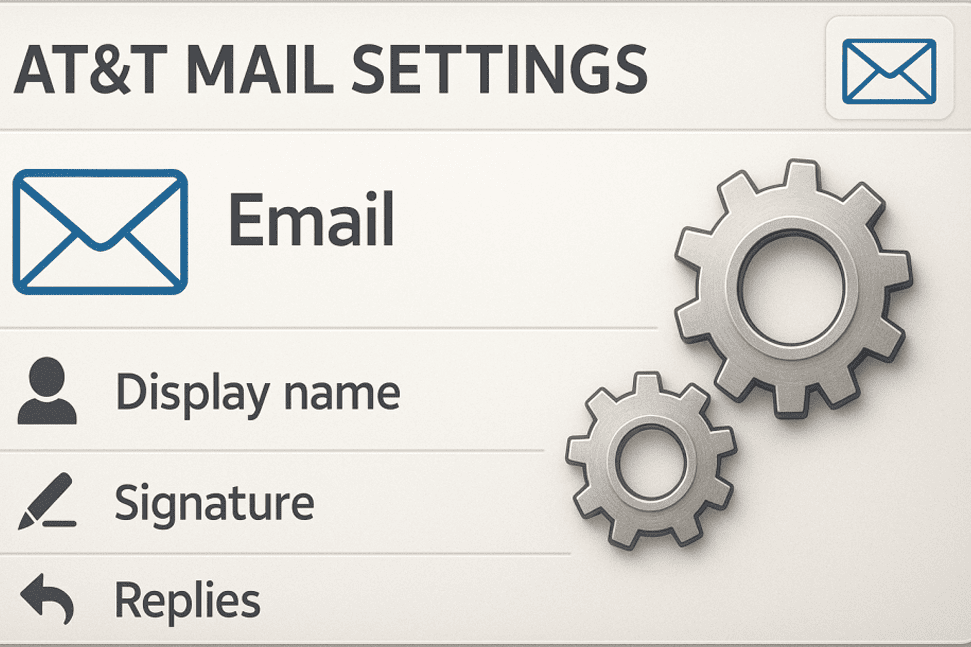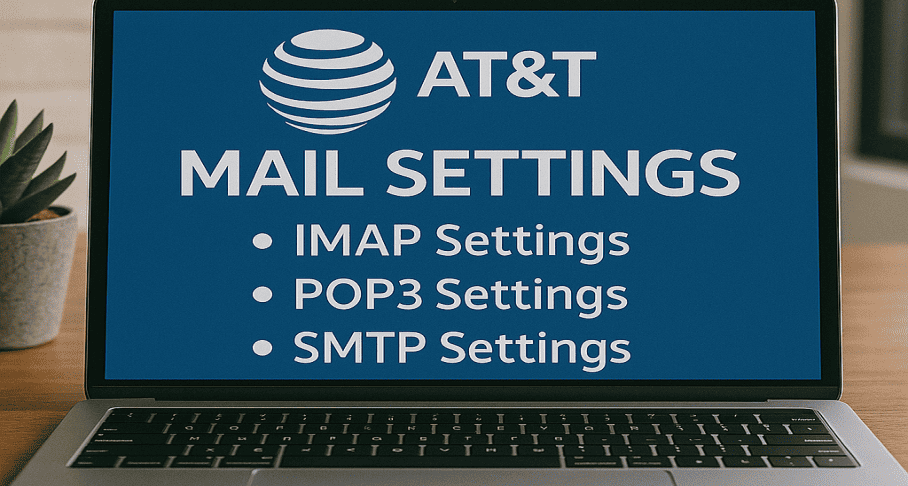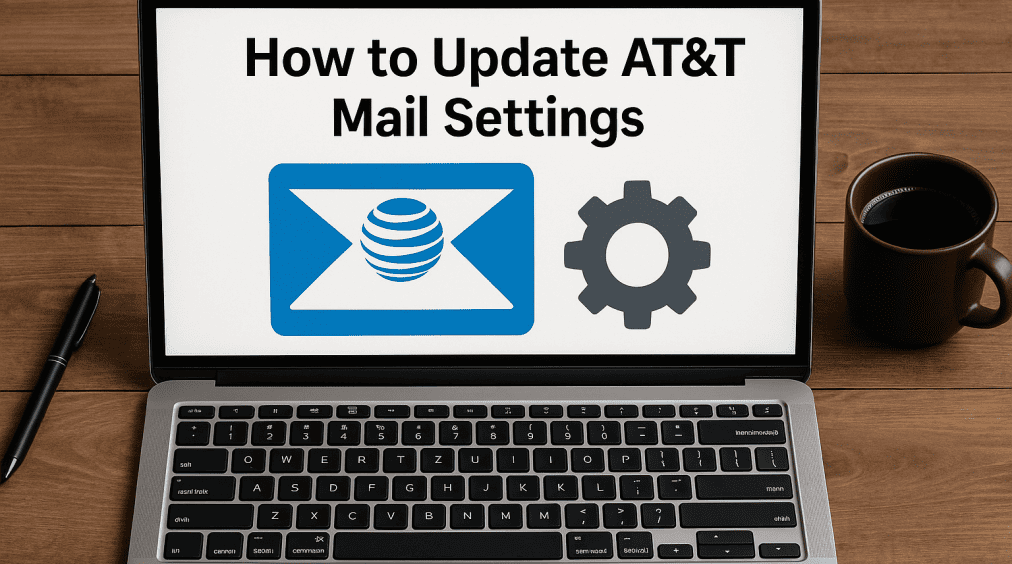ATT Mail Settings
In today’s connected world, having a reliable email service is essential—and AT&T Mail remains one of the most trusted communication tools for both personal and professional use. Whether you’re checking messages on a smartphone, syncing accounts across multiple laptops, or configuring your inbox on a desktop client, the right att email set up determines how smoothly your email experience will run. Because AT&T supports a variety of devices and platforms, getting the correct att mail settings is the key to ensuring consistent access and secure communication.

AT&T operates several legacy domains, including at&t email domain formats such as att.net, sbcglobal.net, and bellsouth.net. Each requires the correct server configuration to function at its best. Using the proper at&t mail server settings, such as imap settings, smtp settings, directly impacts email performance, synchronization, and data protection. Incorrect configurations can lead to login failures, missing messages, or apps refusing to sync altogether.
This blog serves as your complete guide to mastering AT&T Mail. You’ll learn how to configure IMAP, POP, and SMTP for att across every major device. Whether you’re setting up att mail for outlook, configuring at&t net email settings for iPhone, or installing the att email app for Android, this article provides step-by-step clarity. We’ll also explore advanced troubleshooting techniques to help you resolve common issues like sending errors, sync delays, and failed authentications.
By the end of this blog, you’ll have every setting, tool, and method you need to keep your AT&T email running smoothly across all your devices.
Complete ATT Mail Settings (IMAP, POP & SMTP)
Setting up AT&T Mail correctly is essential for smooth performance across all email clients and devices. Whether you’re configuring Outlook, your iPhone, or Android, the right combination of att mail settings and at&t mail server settings determines how well your emails sync and how securely your account functions. AT&T supports all major protocols—IMAP, POP3, and SMTP—allowing users across every at&t email domain to tailor their email experience based on their needs. Using the accurate att email set up ensures secure connections, fast syncing, and uninterrupted access to your inbox.

1. AT&T IMAP Settings
IMAP is the recommended option for all users because it keeps your messages synchronized across multiple devices. With the correct at&t imap settings, your inbox, sent mail, drafts, and folders will stay consistent whether you’re using Outlook, mobile devices, or desktop mail apps. These att mail imap settings ensure real-time communication with the mail server.
-
- Incoming Server: Standard AT&T IMAP server
- Port Number: IMAP secure port supported by AT&T
- Security Type: SSL/TLS required
- Authentication: Mandatory using your AT&T username and secure mail key
IMAP is especially ideal when setting up at&t net email settings for iPhone or integrating your account into Outlook or Android apps.
2. AT&T POP3 Settings
POP3 remains useful for users who prefer downloading emails to a single device. This protocol is helpful for local archiving, limited server storage, or older software that doesn’t fully support IMAP. While IMAP is more flexible, POP can still be practical for simplified workflows.
3. AT&T SMTP Outgoing Server Settings
SMTP handles all outgoing mail and must be configured correctly using the official att smtp settings. Without the right smtp settings, you may experience sending failures or authentication errors.
-
- Server Name: AT&T’s dedicated SMTP server
- Port Options: Secure ports required for outgoing mail
- SSL/TLS Requirements: Mandatory for encrypted sending
- Sending Limits: Daily limits may apply for security purposes
These settings are essential when configuring att mail settings for Outlook, Android, or iOS to ensure reliable outgoing email performance.
How to Generate a Secure Mail Key (Mandatory for Many Apps)
A Secure Mail Key is a special, app-specific password required by AT&T for users who access their email through third-party apps that do not support modern OAuth authentication. Whether you’re completing your att email set up for Outlook, for iPhone, this unique key ensures your account stays protected while still allowing your apps to connect smoothly.

AT&T requires a Secure Mail Key because many older or external applications—such as desktop clients, older smartphones, or certain Android mail apps—cannot process advanced security protocols. Instead of relying on your main password, AT&T uses this key to protect your account from unauthorized access while still allowing stable connections through imap settings, smtp settings, and other essential at&t mail server settings.
1. Step-by-Step Instructions to Generate a Secure Mail Key
- Sign in to your AT&T account using any at&t email domain such as att.net or sbcglobal.net.
- Navigate to the Profile or Account Settings section.
- Look for the “Manage Secure Mail Key” or similar option under email settings.
- Select “Create New Key.”
- Copy the generated key and paste it directly into your email client settings—whether you’re configuring at&t imap settings, smtp settings, or setting up the att email app for Android.
- Save your changes and restart the email application if necessary.
2. Common Mistakes During ATT Email Set Up
- Using your regular email password instead of the Secure Mail Key
- Forgetting to update old devices after generating a new key
- Entering the key with spaces or formatting errors
- Not saving the key before closing the AT&T portal
Generating a Secure Mail Key is essential for smooth performance across all mail clients and ensures that your att mail settings work flawlessly across every device.
ATT Email Set Up on Different Devices
Setting up AT&T Mail across various devices may look different depending on the platform, but one thing remains essential: you must use the correct att email set up, including proper settings, and a valid Secure Mail Key. Because AT&T email continues to operate on Yahoo’s infrastructure, all AT&T users—whether using an at&t email domain such as att.net, sbcglobal.net, bellsouth.net, or pacbell.net—can sync their mailbox across iPhones, Android devices, Outlook, Mac Mail, and desktop clients.

Below is a complete, corrected guide covering each platform with high accuracy and deep detail.
1. ATT Email Set up on iPhone & iPad (iOS)
Setting up ATT email on iPhone or iPad is simple because iOS integrates seamlessly with Yahoo’s authentication system. Since AT&T email is fully hosted on Yahoo’s backend, you can add your account using either the Yahoo option or manual IMAP setup. Both work perfectly, and AT&T fully supports both.
- Method 1: Add AT&T Email Using the Yahoo Option (Recommended for Most Users)
- Open Settings.
- Tap Mail → Accounts → Add Account.
- Choose Yahoo.
- Enter your AT&T email address (e.g., [email protected]).
- You will be redirected to the AT&T sign-in page—this is normal.
- Enter your password or Secure Mail Key.
- Approve login and permissions.
- Select which items to sync (Mail, Contacts, Calendars, Notes).
- Tap Save.
This method auto-detects and configures the correct at&t mail server settings and is the fastest way to perform an ATT mail iOS setup.
- Method 2: Manual IMAP Setup on iPhone (More Control / For Troubleshooting)
- Go to Settings → Mail → Accounts.
- Tap Add Account → Other.
- Select Add Mail Account.
- Enter:
- Name
- AT&T Email Address
- Password (use Secure Mail Key)
- Description
- Choose IMAP.
- Enter the correct at&t imap settings for incoming mail.
- Enter the correct att smtp settings for outgoing mail.
- Tap Next; iOS will verify the information.
- Enable Mail, Notes, and any other service you prefer.
- Tap Save.
This approach is useful when you’re customizing folders or need deeper control beyond auto-setup.
- Recommended iPhone Settings for AT&T
- Use IMAP over POP for multi-device sync.
- SSL/TLS must be enabled on both servers.
- Your Secure Mail Key should replace your password.
- Ensure your iPhone is updated to the latest iOS version.
These adjustments ensure smooth ongoing syncing when using at&t net email settings for iPhone.
- Fixing Common iPhone Sync Issues:
Typical problems include emails not updating, errors prompting for a password, or slow syncing.- Re-enter your Secure Mail Key.
- Toggle Mail off and back on in Settings.
- Delete and re-add the account using IMAP settings.
- Enable “Push” in Mail → Accounts → Fetch New Data.
- Restart the iPhone to refresh background processes.
2. ATT Email Set Up on Android Devices
Setting up ATT email Android accounts can be done through the Gmail app or through the att email app for Android. Gmail remains the most common method because it supports manual IMAP/SMTP input.
-
Method 1: Add AT&T Email in Gmail App (Quick Setup)
- Open the Gmail
- Tap your profile picture → Add another account.
- Choose Other.
- Enter your AT&T email.
- Select Personal (IMAP).
- When asked for a password, enter your Secure Mail Key.
- Gmail will request the correct at&t imap settings — enter them carefully.
- Enter the correct outgoing server configuration using smtp settings.
- Choose syncing frequency and notification preferences.
- Tap Next and complete setup.
-
Method 2: Manual IMAP/POP Setup on Android
- Open Settings → Accounts → Add Account → Email.
- Enter email and Secure Mail Key.
- Choose IMAP (recommended) or POP.
- Enter incoming server details using official att mail imap settings.
- Enter outgoing server details using official att smtp settings.
- Turn on Require sign-in for outgoing mail.
- Enable SSL/TLS.
-
Common Android-Specific Issues & Fixes
-
- Authentication failed: Usually occurs because users entered their original password instead of a Secure Mail Key.
- Gmail not syncing:
- Turn on Sync in Gmail settings.
- Disable battery optimization for Gmail.
- Clear Gmail cache and restart device.
- Emails missing or delayed: Switch from POP to IMAP for real-time sync.
3. ATT Email Set Up on Outlook (Windows & Mac)
Outlook users—whether on Windows, macOS, or ATT Outlook 365—must manually configure AT&T email for best results. Outlook often struggles with auto-discovery, so manual entry ensures accuracy.
-
Manual IMAP Setup in Outlook (Preferred Method)
- Open Outlook → File → Add Account.
- Enter your AT&T email and click Advanced Options.
- Check Let me set up my account manually.
- Choose IMAP.
- Enter the correct att mail imap settings (incoming).
- Enter the correct att smtp settings (outgoing).
- Use your Secure Mail Key as the password.
- Set encryption to SSL/TLS for both IMAP and SMTP.
- Save and restart Outlook.
This ensures a complete and reliable ATT Outlook setup.
-
Adding Secure Mail Key in Outlook:
If Outlook repeatedly asks for a password:
- Go to File → Account Settings → Server Settings.
- Replace old password with your Secure Mail Key.
- Make sure “Require logon using SPA” is not checked unless AT&T instructs otherwise.
- Restart Outlook.
-
Fixing Outlook Sync or Sending Errors:
Common issues include folders not updating, messages stuck in Outbox, or server authentication errors.
- Re-enter all at&t mail server settings.
- Use SSL only—avoid STARTTLS if issues persist.
- Clear Outlook’s credential cache in Windows Credential Manager.
- Remove the account and re-add using manual IMAP.
4. ATT Email Set Up on Mac Mail (macOS)
Mac Mail offers full IMAP functionality and works smoothly with AT&T’s Yahoo-powered backend.
-
Step-by-Step Setup in Mac Mail
- Open Mail.
- Click Mail → Add Account.
- Choose Other Mail Account.
- Enter your Name, AT&T Email Address, and Secure Mail Key.
- Choose IMAP.
- Enter incoming server values using the correct at&t imap settings.
- Enter outgoing server values using the proper att smtp settings.
- Authenticate and save.
-
SSL Certificate Issues on macOS:
macOS may warn about certificates if outdated cached settings conflict.
- Click Continue and choose “Always trust this certificate.”
- Remove old Keychain entries related to AT&T or Yahoo servers.
- Ensure SSL is enabled for both incoming and outgoing mail.
-
Calendar & Contacts Sync Notes:
AT&T email syncs mail only — not contacts or calendars.
- Use Yahoo Mail app for macOS.
- Export/import contacts manually.
- Use CardDAV/CalDAV if supported by your provider.
5. ATT Email Set Up on Thunderbird & Other Desktop Clients
Thunderbird and similar apps require manual configuration but give excellent control.
-
Manual IMAP/POP Setup in Thunderbird
- Open Thunderbird → Account Settings → Account Actions → Add Mail Account.
- Enter your Name, AT&T Email Address, and Secure Mail Key.
- Click Manual Config.
- Enter incoming server details using official att mail imap settings.
- Enter outgoing server details using official att smtp settings.
- Set both Incoming and Outgoing to SSL/TLS.
- Re-test configuration → Done.
-
Authentication Issues in Thunderbird:
Thunderbird may display errors like “Unable to authenticate” due to:
- Using a normal password instead of Secure Mail Key
- Wrong port numbers
- Incorrect username format (must include full email address)
- SSL disabled
Fix: Re-enter all values carefully and restart Thunderbird.
Also Read: ATT Email Login
AT&T Email Security Tips & Best Practices
Keeping your AT&T email account secure is just as important as using the right att mail settings across devices. Since AT&T email operates through Yahoo’s robust infrastructure, users can take advantage of several powerful security features to protect their inboxes while maintaining smooth performance with the required at&t mail server settings, imap settings and smtp settings.
-
Enable OAuth for Supported Apps:
Whenever possible, use OAuth-enabled applications such as the Yahoo Mail app, Outlook 365, or the att email app for Android. OAuth eliminates the need to store passwords and improves overall security.
-
Create Unique Secure Mail Keys for Each Device:
Instead of one shared password, generate individual Secure Mail Keys for your iPhone, Android, Outlook, or desktop apps. This ensures that your at&t net email settings for iPhone, for Outlook and other clients remain secure and isolated.
-
Use App-Specific Passwords When Required:
Older apps or manual IMAP/SMTP configurations (such as those using att mail imap settings or smtp settings) may need app-specific passwords to prevent unauthorized access.
-
Manage Spam & Junk Filters:
Adjust your spam settings directly through the AT&T/Yahoo webmail interface. Marking items as spam or not spam helps refine filters over time.
-
Recommended AT&T Security Tools:
AT&T provides built-in security services including two-factor authentication, suspicious login alerts, and secure connection requirements for all at&t email domain accounts—strengthening security across every device.
How to Update or Change ATT Mail Settings
Updating your AT&T email configuration is often necessary when switching devices, correcting sync issues, or applying new security requirements like Secure Mail Keys. No matter which at&t email domain you use, adjusting your att mail settings ensures reliable performance across iPhone, Android, Outlook, and other mail clients.

-
Modifying Server Settings in Different Apps:
In most apps—such as the att email app for Android, Gmail, Apple Mail, or Outlook—you can access account settings under the Mail or Account Management sections. From there, you can update your at&t mail server settings, replace your password with a Secure Mail Key, or manually modify your at&t imap settings, att mail imap settings, or att smtp settings. Make sure SSL/TLS remains enabled to maintain security.
-
When to Switch to IMAP:
Switch to IMAP if you want real-time syncing across multiple devices. IMAP is ideal if you’re using at&t net email settings for iPhone, Outlook, Android, or webmail because it keeps all folders updated simultaneously. POP should only be used for local, single-device storage.
-
How to Delete & Re-add Accounts Safely:
If settings become corrupted, the best fix is often to remove the account entirely and redo your att email set up. Before deleting, verify you’re using IMAP so no emails are lost. Then re-add the account using fresh server details and correct smtp for att
FAQs
Q1. What is the correct way to complete my ATT email set up on different devices?
- A. The correct att email set up depends on using accurate at&t mail server settings like IMAP for incoming mail and SMTP for outgoing mail. These must be entered correctly whether you’re setting up iPhone, Android, Outlook, or desktop clients.
Q2. Which AT&T IMAP settings should I use for secure email access?
- A. You should use the official at&t imap settings, which include the correct incoming server, SSL/TLS security, and your Secure Mail Key. These att mail imap settings ensure real-time syncing across all devices.
Q3. Do I need different AT&T mail settings for each AT&T email domain?
- A. No, All at&t email domain addresses—like att.net, sbcglobal.net, or bellsouth.net—use the same att mail settings for IMAP, SMTP, and security configurations.
Q4. How do I enter AT&T mail settings for Outlook?
- A. When configuring att mail settings for Outlook, you’ll need to manually enter the IMAP and SMTP details, enable SSL/TLS, and use your Secure Mail Key. Auto-setup may fail, so manual setup is recommended.
Q5. How do I configure AT&T net email settings for iPhone?
- A. To set up at&t net email settings for iPhone, add your AT&T email through the Yahoo option or manual IMAP setup, enable SSL, and use a Secure Mail Key as your password.
Q6. Do I need to update my AT&T mail settings when switching devices?
- A. Yes, If you change devices, it’s important to re-enter the correct att mail settings and create a new Secure Mail Key. This applies to iPhone, Android, and desktop clients using at&t mail server settings.
Q7. Is it necessary to enable SSL/TLS for AT&T email?
- A. Yes, SSL/TLS ensures a secure encrypted connection for both incoming and outgoing mail. This applies to all at&t mail server settings, including IMAP and smtp settings.
Q8. Can I use multiple AT&T email accounts on the same device?
- A. Yes, you can add multiple accounts using any supported at&t email domain. Just ensure each account has its own Secure Mail Key and correct server configuration.
Conclusion
Setting up AT&T email correctly is essential for maintaining a secure, reliable, and seamless communication experience across all your devices. Whether you’re configuring your inbox on an iPhone, Android phone, desktop, or Outlook client, using the right att email set up steps and accurate att mail settings ensures that your emails sync properly and your account stays protected. Every at&t email domain, from att.net to sbcglobal.net and bellsouth.net, relies on the same core at&t mail server settings, making it easier to configure your account once you understand the fundamentals.
Choosing the recommended at&t imap settings is crucial for multi-device syncing and real-time updates, while correct att smtp settings ensure smooth outgoing communication. Whether you are using att mail settings for Outlook, for iPhone, or adding your account to the att email app for Android, the same principles apply: use SSL/TLS, apply your Secure Mail Key, and keep your credentials updated.
By following the detailed setup instructions and best practices outlined in this blog, you can eliminate sync errors, authentication issues, and sending failures. Accurate att mail imap settings, proper configuration of outgoing servers, and secure password management form the foundation of a trouble-free AT&T Mail experience.
As AT&T continues leveraging powerful Yahoo infrastructure, users benefit from enhanced stability, improved security, and cross-platform compatibility. With the right settings in place, your email will remain accessible, protected, and perfectly synchronized—no matter where or how you use it.
For more information regarding ATT Mail and issue other issues and solutions for it, go to our ATT Email Support page.

